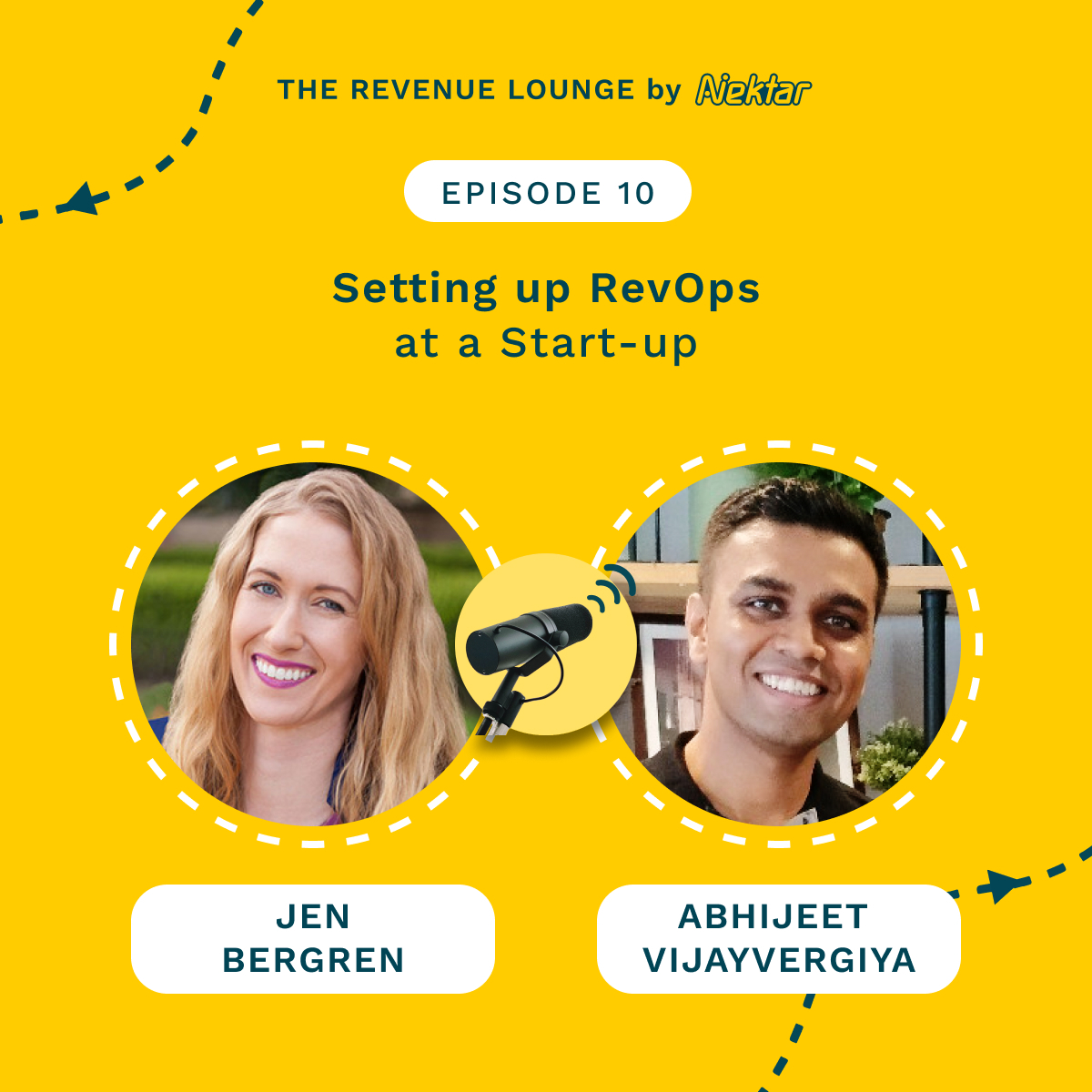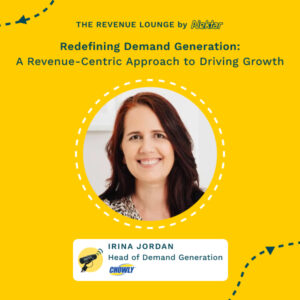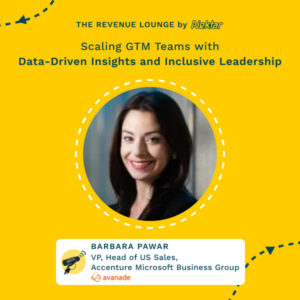The Flywheel Approach to Driving Full-Funnel Revenue Impact ft. Anil Somaney
December 17, 2024
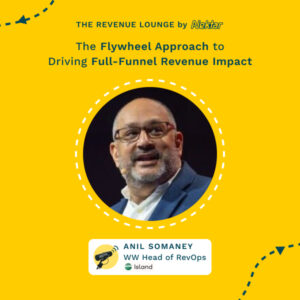
About
The Revenue Lounge
The podcast covers stories from leaders across RevOps, Sales, Customer Success, GTM, Data and Marketing about what drives these functions and what advice they would share with our listeners. With 3 seasons recorded, the podcast currently features 50+ enterprise leaders in the B2B SaaS domain. Tune in to hear from the best in the business
In this conversation, Anil Somaney discusses his excitement about joining Island, the evolution of RevOps from siloed functions to a strategic role, and the importance of aligning metrics across departments. He introduces the flywheel framework as a method to enhance go-to-market strategies and emphasizes the need for effective data management and the role of AI in optimizing operations. In this conversation, Anil Somaney and Randy Likas discuss the evolving role of AI in sales, the challenges of sales engagement, the importance of human connection, and the complexities of buying committees. They also delve into the debate surrounding attribution in sales and share insights on RevOps and career growth. The discussion highlights the need for a balance between technology and personal interaction in the sales process, as well as the importance of collaboration and alignment among stakeholders.
Key takeaways:
Island’s growth potential in the enterprise browser market is significant.
Collaboration among intelligent teams is crucial for success.
RevOps is evolving into a strategic function that requires both tactical and strategic skills.
The structure of RevOps can vary, but independence is key for effectiveness.
The flywheel framework helps integrate various operational components for better efficiency.
Alignment on metrics across departments is essential to avoid silos.
Data hygiene is critical for effective decision-making.
AI is becoming increasingly important in sales and operational processes.
Change management requires open discussions and collaboration among teams.
Technology should automate data entry to allow reps to focus on driving deals. AI is evolving in sales, but human connection remains vital.
The market is ready for significant shifts in sales technology.
Sales engagement faces challenges due to automation fatigue.
Buying committees are becoming more complex and hidden.
Attribution in sales is complicated but necessary for measuring ROI.
RevOps plays a crucial role in aligning sales and marketing efforts.
Thought leadership and education are key in engaging prospects.
Stakeholder alignment is essential for successful initiatives.
Career growth in RevOps requires collaboration and communication skills.
Understanding the buyer’s journey is critical for sales success.
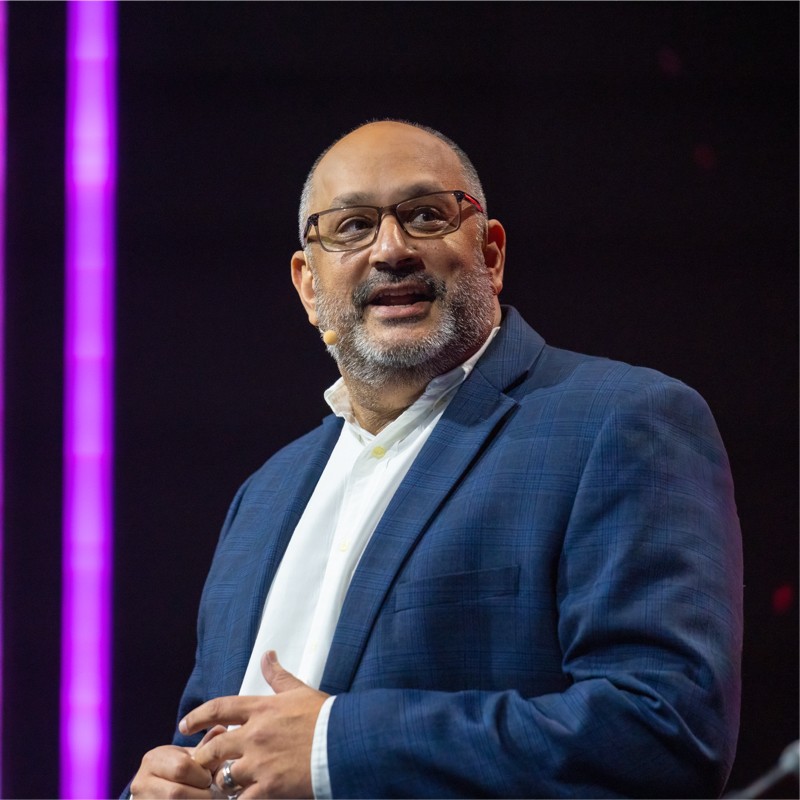
Randy Likas (00:02.01)
Hello, everyone. Welcome to the Revenue Lounge podcast. I’m your host, Randy Likus. And in this episode, we’ll unpack a proven framework for architecting a cross-functional go-to-market engine and revenue operations flywheel methodology. Joining me today is Anil Samani. Anil has built revenue operations and led go-to-market strategy for some of the fastest growing SaaS companies over the last 10 years, companies like Splunk, Cloudflare, Pluralsight, and ChargeMe. Most recently, Anil joined Island, where he’s the worldwide head of revenue operations.
And Neil, thanks so much for joining us today.
Anil Somaney (00:33.285)
Yeah, thanks, Randy. I’m really excited to be here.
Randy Likas (00:35.258)
Yeah, me as well. So, Anil, I usually like to start these by having you talk a little bit about your background. And you’ve got a really interesting background, right? So, and I don’t expect you to start all the way back to your AT &T days, but like you were a, you were an FP &A analyst, right? And then you got into sales ops, and then you moved into, you into, you had a sales, like a sales role where you held a bag, you led business development teams, and then you sort of settled in over the past several years in rev ops. So maybe walk us through that journey a little bit and, you know, give us a little bit of flavor in terms of, you know, how you got to where you are today.
Anil Somaney (01:04.903)
Yeah, that’s great. I did start as a FDNA analyst and I love the…
The ability to really think about things from an analytical and an ROI perspective, long range financial modeling, things like that, that really proved a cornerstone from a skillset perspective, but very quickly moved over into sales ops and then led a couple of sales teams. And for me, hopping back and forth between sales and operations gave me a really unique perspective on what the other team was working through and the challenges that they faced. And also sitting on the sales side, just how to articulate the problem.
Just kind of saying, hey, process is stink doesn’t help us. And so being able to really pinpoint what was wrong and how it was wrong and maybe even come up with some ideas so the ops team that was supporting me can fix that. From there, I moved into Biz Dev and most good Biz Dev teams have a really high operational element to them. And I loved the kind of fine lines sitting in front of customers or prospects and also then the operational element.
And then, you know, the last few years absolutely have been, the last 10 years or so have been rev ops and kind of thinking about full go-to-market and how focusing on that.
Randy Likas (02:20.644)
So you’ve been at Island for about a month or so, give or take a couple of weeks. They’re just on a trajectory, man, growing like crazy, and especially in this market, right? It’s crazy. So just curious, what got you excited about the job, and why’d take it?
Anil Somaney (02:35.515)
Yeah, I’d say it’s three things for me. Coming in and looking at the marketplace and understanding how unique of a solution that Island actually is was number one for me. I really thinking about any one individual point in our platform is a company, right? I there multiple companies that live off of that. So I was just looking at the marketplace and our penetration and just general enterprise browser.
Just got me really really excited. I’m a little bit of a technical nerd and so I love that and really enjoyed that part of it Number two was the people as I kind of engaged with different people throughout the interview panel You could see the high intellectual ability Across, know, everyone was extremely methodical about the way they operated But then I also felt like this really tight collaboration I’m getting a lot of that noise
Randy Likas (03:32.72)
It’s getting louder, yeah. Let me pause the recording.
Anil Somaney (03:34.375)
Yeah.
Randy Likas (00:01.272)
So, Anil, was taking a look at Island and I know you started like four or six weeks ago and I mean, what an incredible company. Like the growth right now has been incredible. like just curious, what is it that got you excited about the job and kind of why’d take it?
Anil Somaney (00:14.492)
Yeah, it’s an awesome company. I’d say it’s three main factors. One is the marketplace. So as I looked at Island’s product and the market penetration and how things were working across the enterprise, you could just see the large ability to see a significant growth across many years. And I think that enterprise space, enterprise browser space is still highly underdeveloped right now. And we really see the enterprise browser as a delivery mechanism.
many different solutions. So I’d say just the market potential was one. Number two was the people. So the interactions I had throughout the interview stage across the panel, I felt like it was a highly intellectual group, very methodical, but I felt this sense of collaboration. And that’s pretty rare from my perspective, where you get just really smart people in a room wanting to work together.
It was just phenomenal. In fact, I goosebumps talking about it. It’s just a cool place. And then three, as I listened to the challenges that the company was facing, it was something that I felt like I was pretty good at and could, know, skill set wise, it felt like just a really good job match. So, you know, across all those different reasons. And then, you know, it’s based in Dallas and that’s kind of where I grew up. So, yeah, there were just so many similar, there were so many.
Randy Likas (01:35.47)
Was that right? Yeah.
Anil Somaney (01:39.132)
Kind of good parallels throughout that and the clicks throughout the interview process just came.
Randy Likas (01:43.5)
Yeah, that’s awesome. Congrats. Let’s dive in a little bit. So in preparation for this call, I listened to a couple of different interviews or podcasts that you’ve done in the past. And I’ve heard you talk about this evolution of rev ops, from maybe being like these siloed functions that we’re serving as the sales ops, marketing ops, success ops, to an evolution now that we’re seeing over overarching.
you know, operational function that looks at the entire customer lifecycle. And you talked also about the evolution of the profile, right? So it’s not really a support function or a one way, but more of a strategic leader and advisor. So of course it’s different from company to company, right? But I’m just curious like about this evolution. What do you think has like, has driven that? And can you talk to me a little bit about like what that strategic rev ops leader role looks like?
Anil Somaney (02:37.17)
Yeah, and I’d say the tactical versus strategic is also just different by project, They’re meetings where we’re absolutely tactical, where you’re running forecast calls, you’re setting up forecast calls.
And that’s just a part of the job, right? And that’s just a part of what you do to help the business run. And then there are other parts of the job where you’re very, very strategic. So what I found is the ability to really oscillate between that strategic layer and operate tactically, and neither one should be beneath or above you, right? And so finding people that can do both of those functionalities is really critical.
And then I’d say back to your question around the evolution. You know, I think the marketplace over the past five, 10 years, the economy, the environment by which we’re all operating within has changed drastically. And so the need to adapt, go to market systems. Now you’ve got the injection of AI coming in, right? And that’s going to disrupt a lot of things. And so the ability to be nimble and to really think quickly and pivot based upon some trends that you’re seeing, maybe a new competitor enters the marketplace.
Randy Likas (03:31.586)
Yeah. Yep.
Anil Somaney (03:42.854)
is really where I see rev ops playing in. And then I’d say there’s also been this premium on productivity and efficiency now from a market perspective. And a lot of companies are trying to figure out how to maximize the output given the same amount of resource and sometimes less resource.
Randy Likas (03:50.336)
Mm-hmm. Yep.
Randy Likas (04:02.316)
You, I think you talked about it before, but where do you think RevOps should sit in an organization from a structural standpoint? I’ve seen it many different ways. I’ve seen it go into a CRO. I’ve seen it be into finance. Where do you think, where have you seen it historically and where do you think the best fit for RevOps is?
Anil Somaney (04:22.428)
Yeah, I’ve seen it all over. I’ve seen it CFO, CEO, COO, CRO, are probably the core places I’ve seen it. I would say that I don’t have a strong preference as long as the individual and team have the ability to operate across the full go-to-market framework and really engage and help make decisions and help drive kind of functionality.
Less important is where it rolls. More importantly, that can be an independent source of truth, right? If you roll it into the CRO and the CRO is kind of hiding some stuff or asking, you feel bad when you expose some low productivity numbers, then it’s not an effective use. But if you roll it into a function that’s completely independent, then maybe you get a little more of that cross-functional dialogue.
Randy Likas (05:13.09)
Yeah, 100%. And then just to go back on the structure a little bit. am I safe to assume that you’re not suggesting that there’s not still a marketing ops person or a customer success ops person? It’s just they’re not siloed, right? They’re part of the cohesive rev ops strategy, right? You still have sort of the specialists that sort of work on that function. Is that accurate?
Anil Somaney (05:34.024)
Yeah, that’s right. mean traditionally how I’ve structured my team is there’s an arm of field operations and under field ops is marketing ops, CS ops, partner ops and sales ops and even BD ops at times, right? And each one of those you think about marketing ops is going and looking at all the individual marketing kind of metrics, the conversion rate, the keyword effectiveness, all that good stuff and each one of those functions
partners and supports with their respective C-level executives, their teams that they’re partnering with. Then there’s this center of excellence that I’ve set up in the past where, you know, sales compensation, territory planning, segmentation, insights, analytics, tools and tech, stuff like that can live. Then global enablement that supports the entire business. And then traditionally I’ve had a business transformation role and that business transformation role
A little bit project manager, but also owns AOP and really drives large cross-functional initiatives across the business.
Randy Likas (06:41.836)
Is that business transformation synonymous with what we see a lot of like go-to-market strategy?
Anil Somaney (06:46.63)
Yeah, I mean, I would say go to market strategy. That person is thinking 6, 12, 18 months out as well, right? So someone that is not mired in the day to day, but also has the ability to think through a larger lens.
Randy Likas (07:02.082)
Let’s dive into the topic of the podcast, is the framework, right? Or the flywheel, I’m sorry. So I want you to walk us through it. Tell us more about sort of how it works and the different components that make up the flywheel.
Anil Somaney (07:17.468)
Yeah. I mean, you know, from my perspective, the flywheel is just that, right? Like it’s a series of levers and pulleys and knobs that make up a go-to-market ecosystem. And if you drive that relationship into sales, marketing, CS, systems, processes, tools, organizational structures, and you view all those as different leverage points in there, the way I think about a flywheel is any one large initiative, how do you systematize it and put energy into the machine?
get it spinning in such a way that the reduced input can deliver an outsized impact, right? Can deliver more output. And along the way, are you turning those levers and knobs and pulleys to be able to maximize and drive efficiency in products?
Randy Likas (08:05.902)
So how do I ask the question? Why is it needed? So what are the challenges that you’re trying to solve for with the flywheel?
Anil Somaney (08:17.19)
Yeah, I just think that having a framework by which someone thinks about all that, right? Because so many times you’ll see these siloed frameworks or these siloed thinkings and not to pick on marketing, but it’s just the front end of that bus, right? That you’ll see a marketing demand generation group think about, how can I maximize from MQ or from leads even at the inquiries all the way to MQLs? And they’re solely looking at that.
and thinking about, just how do I get more on the top of the funnel? Which is awesome. That’s a really, really good thing to think about. But in addition to thinking through the conversion rate and how does that pour through to SQL? How does that pour through to close one? Many people don’t think about it. How does it pour through to churn and NRR? And so really starting to tie the full go-to-market ecosystem together is why, you know, the flywheels, and to me, it’s just an awesome analogy that fits that.
Randy Likas (08:48.866)
Yeah. Yep.
Anil Somaney (09:13.916)
There are plenty of other ones that can help you think through.
Randy Likas (09:17.57)
Yeah. So we talked to a lot of different go-to-market leaders and it’s amazing to me how, and this I think fits why the firewall is needed, how marketing is celebrating that we hit our MQL goal, but we missed our numbers, right? There’s these different metrics that one company gets excited about and the other one misses. It’s like…
we should all be aligned on the same thing. so I think that’s kind what you talk about with like these silos and in these different metrics. Am I on track here? Is that kind of what you’re trying to do?
Anil Somaney (09:50.376)
100%. And I think, you know, like one of the things you can, you can get metrics overload, right? Even, even within, let’s shift to sales, like even within sales, you can get metrics overload. You can look at conversion rates, you can look at activities, you can look at close one, you can look at messaging, you can look at ASP, ACV, like there’s so many things you can look at. So getting a consistent framework, even from a metrics perspective, whether you call it the dirty dozen, the top 10, I don’t really care, but.
Pick 10 metrics as an executive team that you want to see week over week over week and start measuring those. Start getting aligned on the definition of those like close rate versus win rate. There’s so many of those types of things and hold a meeting weekly to think about it, right? And to really measure one of the meetings that, and it fits right within the flywheel, one of the meetings that…
you know, I’ve led in the past and run consistently across my different companies, is this pipeline meeting, right? Pipeline’s always a source of contention and, we didn’t give you enough leads, they weren’t very good, and then the marketing side, you’re not following up on them. It’s just like a battle as old as time. And so getting to a point where you’re measuring those key metrics and then asking three questions every meeting. What happened? Why did it happen? And what are you doing about it?
Randy Likas (11:01.56)
Yeah.
Anil Somaney (11:14.408)
really salient to be able to get to the root of the problem. so having someone, whether it’s a marketing problem, whether it’s a sales problem, whether it’s CS problem, it’s systems, I don’t really care. But getting to the root cause of what happened that week in the trend, understanding why, and then most importantly, how are we going to go fix this thing, right? And so I’ve always kind of subscribed to the fact that, hey, look, if we do something wrong,
That’s OK. If we tried something, we experimented, and something didn’t work, that’s cool. Let it run a leak. Identify it. Go fix it. Don’t let it go six weeks and then tell me, hey, something’s off. And we did this way back when. And now we’ve wasted a lot of money doing this.
Randy Likas (11:58.872)
Yeah. So what are the different components that make it up? So you’ve got probably goals and alignment on the metrics. There’s probably different ways in which you need to incent it. You’ve got to enable on it. So can you talk about what the different components are and then what is the operational rhythm to manage to it?
Anil Somaney (12:18.598)
Yeah, I think, you know, it’s kind of the old school systems processes and tools, right? Or it’s just people. That’s kind how I think about it, right? So if you think about going into any one flywheel methodology or any one initiative that runs through the flywheel, thinking about the systems and the tools and the tech that supports that, the processes then, think about handoffs, think about messaging, think about SLAs, how quickly are we supposed to respond?
Randy Likas (12:23.138)
Yeah, yeah.
Anil Somaney (12:48.264)
Even back in tools automation AI or their leverage points there and then people do we have the right people to be able to support this process? That’s just I mean that alone is a phenomenal start to just thinking about like how you launch one initiative right behind all of that you hit on it is enablement Making sure that the field whether it’s BDRs SDRs AE CSM support are all aligned in what we’re doing I mean the worst thing that can happen is
messaging on the front end and marketing’s going out and buying leads for XYZ and then it gets to CS and they’re like, yeah, we can’t do that, right? And so just misaligned ICPs along the way. And then I think measurements, the most important part of a lot of this and being frequent and deliberate about what you’re measuring and how often so that you can fix, if anything’s gone sideways, you can fix it.
Randy Likas (13:24.888)
Yeah.
Randy Likas (13:41.954)
Yeah. I’m going to make a statement that I don’t know if it’s true, so correct me if I’m incorrect. So I would imagine that as you go to implement this, maybe companies don’t have it or don’t have such a structured methodology, and maybe they are working in silos, that there’s some change that has to take place. And so I’m just curious, if someone’s trying to implement a framework, whether it’s a flywheel or other,
What are some recommendations you have in terms of how do you manage that change with those internal stakeholders?
Anil Somaney (14:15.048)
Yeah, I think that the best frameworks flywheel or anything else is the ones where you really don’t know you’re in it. Right. So like the flywheel methodology is something that came about from actually an old boss of mine where, you know, he kind of, were going through launching one new initiative and we went through that full process and you know, he kind of turned over to me about six weeks later and he’s like, you know what? You’re really good at this. I’m going to start calling you the flywheel executive.
Randy Likas (14:21.646)
Yeah.
Randy Likas (14:41.486)
You
Anil Somaney (14:42.416)
And I’m like that that is actually perfect description of what I enjoy doing. So Back to your question though. I think the best one is when you don’t know you’re in it So a lot of times what I like to do is when you’re sitting in any one meeting Asking the owner the the C level owner or the VP level owner About the impact of that initiative one click down just downstream one click. So you think about marketing? Okay, awesome. We want to do this
How is that going to impact our conversion rate throughout the funnel and our closed one? Just asking that simple question gets people thinking just to touch up. And a lot of times, these folks are all really, really smart. So everyone’s going to pick up on that. Asking the salesperson, hey, what happens to churn if we go after this new ICP or relaunch this new promo? And then you just start opening a little bit, and you get to a point where everyone’s thinking across this full lifecycle.
Randy Likas (15:15.287)
Mm-hmm.
Anil Somaney (15:37.328)
I mean, think people just welcome the discussion, the debate, and the measurement behind it.
Randy Likas (15:42.38)
Yeah. When you think about aligning different functions, marketing, sales, CS, what are common, I mean, there’s probably some common, I guess, buckets or areas where you’re seeing misalignment, right? And so how do you address that? Like, what are the best ways to sort of break down some of those silos and get that alignment?
Anil Somaney (16:01.916)
Yeah, I think it’s putting everybody in a room together and just asking those questions. What happened? And you will very, very quickly start getting to the root of the problem and people will expose everything in front of each other. Right. And so the goal is not to bust anyone out or to, you know, kind of show anyone’s weakness. It’s more so like, how do we build this collaboratively? And so, you know, if marketing is running an initiative and it’s going to impact sales, then the sales leader can step up and say,
yes, then I need to do something different to be able to catch these or to be able to do this. And then you start driving this partnership and this cohesiveness. So I don’t know. I’m a big fan of just like, hey, let’s get everybody in a room together. Let’s talk about it. And generally, you’ll find at most levels, people are willing to collaborate. want success from a company perspective.
Randy Likas (16:51.148)
Right, yep.
So I think probably the underpinning of this is data, right? Data to make good decisions. look, I don’t care what organization it is. don’t think anybody ever has perfect data, right? Data’s, in fact, I’m actually surprised how many times people know they have bad data, but they have to make decisions anyway. And so we make decisions in the data that we have. So.
Data, you know, I mean, there’s many root causes of bad data, different systems, people not updating things. Talk to me a little bit about like, how do you work in a world where you don’t have perfect data and what sources do you go to to try to make these decisions in this world of imperfect data?
Anil Somaney (17:39.378)
Yeah, I think there’s so many different forms of data, right? Like there’s prospect data, there’s customer data, there’s internal data of engagement, there’s all different types of data, and the answer is different for each one of those. Generally with external data, firmographic, technographic, I deploy kind of this three-step methodology where I like to go look at three different sources of data and rub those data sources together.
You know, if data source one is missing field 12, 19, and 26, awesome. I’ll go append that with data source two. I’ll pull those two and three together. And then ultimately you get this best of breed record that then from an external perspective starts looking better. The other thing I’d say is differences in data also happen by region, right? Like if you think about contact centric information, you think about phone numbers and GDPR, there’s just…
Randy Likas (18:21.827)
Yeah.
Anil Somaney (18:38.12)
There’s a ton of laws and regulations, but then there’s also data vendors that play well in Namer versus EMEA versus APAC. And so you really have to be cognizant of that. Internally, it’s about hygiene, And so building a process, a lot of times what I’ve found is data is weak when the system is overly cumbersome, right? So if you’re asking an AE to go create an op and fill out 22 fields, I promise you field number 22.
Randy Likas (19:00.366)
Mm-hmm. Yep.
Anil Somaney (19:07.76)
is going to be zero or garbage, right? And so I think having a person or having someone really understand the click streams of what an AE, an SDR, a CSM go through day in, day out and explain the importance of, look, like here’s field number four, and it’s really important you fill this out because here’s what I’m going to use number four for. And being able to really just get them understanding that.
Randy Likas (19:09.752)
Get Grabbed with Ya.
Anil Somaney (19:35.464)
Then you find, okay, hey, the system’s not so overbearing on a person. And you explain to them why, then you’ll see them drive proper hygiene. The last piece is just making sure the systems and processes have the proper check and balance, right? And so as you think about sales stages, right? Like one of the big things that every company I’ve been at are these $0 ops coming over for marketing and sales never adds a dollar value onto it.
Randy Likas (19:40.557)
Yeah.
Anil Somaney (20:04.072)
It’s battle as old as time. But is there a way to put in a sales stage blocker that says, OK, look, you can’t advance this to stage three until it has a dollar value. So now there’s a system block on it before it starts moving forward. So also having the system support your process in those critical fields.
Randy Likas (20:18.102)
Yep.
Randy Likas (20:22.594)
Yeah, it’s a fine line between making sure we got the essential data and not hindering the sales rep to be like, can’t, you know, I got other things to do, right? But yeah, it’s really interesting. The other thing I’d say is I think technology has gotten to a point right now where like you shouldn’t be asking your rep, there’s always gonna be some manual entry, but like you should be able to automate a lot of that into the systems anyway, right? And if you’re not doing that, like shame on you because like your reps should be spending more time thinking about how do I drive deals.
Anil Somaney (20:30.386)
Yeah.
Anil Somaney (20:46.066)
down.
Randy Likas (20:52.398)
CSMs, how do I deliver outcomes for my customers? so I think the technology has gotten to a point where it is. But curious to get your input, both on that, I guess, that comment, but also what role do you see AI playing around data?
Anil Somaney (21:07.996)
Yeah, the first piece of that, I agree with you, right? Like, I can auto-populate the average ACV based upon the last 100 transactions. I can use small, medium, large based upon the company and put in a dollar value. I personally feel like if the AE puts that number in, because ultimately they’re held accountable for it, right? So if I was an AE, I wouldn’t want anybody else messing around with my
and putting dollar values in and inflating it or deflating it, right? And so generally what I found is when you work with AEs and you explain to them the why in that scenario, they’re good about it, right? mean, AEs have a tough gig, but they’re good about updating and getting it right, as long as you have the right kind of commentary behind it. I think AI is just such a loaded one right now. It feels like there are a ton of companies out there
Randy Likas (21:38.606)
Yeah.
Anil Somaney (22:03.72)
really going all in behind AI and then on the other side, this host of companies that are trying to just figure it out and understand the application. I’ve heard some comments that, you know, like, look, if you’re not engaged in some level of AI, you’re already left behind. I saw a demo, I think it was what, last week, the week before, of a 100 % AI selling tool. And it was an AI bot.
Randy Likas (22:10.892)
Yeah. Yeah.
Anil Somaney (22:29.36)
And on the surface, you’re like, all right, there’s no way, but this was an exclusive demo, 10 executives they pulled together and they had, I forgot her name, what the AI box name was, but they had her pitch us. And it is amazing to me to watch the evolution of AI where we all hopped in and we tried to play a little bit of stump the chump where we kind of just asked her tough questions. know, give me customer references.
Randy Likas (22:54.872)
Yeah.
Anil Somaney (22:58.112)
And literally what they would do is they’d pull up a slide. This is all AI. Pull up a slide of core customer references, specialize to my vertical, in parallel, sent three emails off to existing customers with me CC’d on them with an intro. And it was just so amazing to watch that person, that AI bot, interact with us. In the end, you could program sales methodology.
So she would, you know, instead of the old school band, you know, this, at least this one was programmed on MedPic, where she was kind of the questions and the way she was leading it was straight down the MedPic path. She was talking about ROI. She was talking about our business. Like it’s amazing to watch the evolution of that. And I think some people it scares a few people. Some people, you know, it could potentially take a few jobs. So I think there’s just this, the market is primed for another shift and
Randy Likas (23:31.843)
Mm-hmm.
Randy Likas (23:45.964)
Yeah.
Anil Somaney (23:55.964)
and I think we’re slowly starting to feel it.
Randy Likas (23:58.424)
Do you think it’s, in that example of that tech, sounds really cool, it might work in like SMB, low ASV deals, right? But as you get up market, what are your thoughts there? Do you think?
Anil Somaney (24:11.61)
It’s exactly where we pushed, right? like, yeah, I mean, we’re like, all right, you want to sell the Joe’s Joe’s barn grill? Cool. This is awesome. And they said, no, like, let’s now turn around and pretend we’re a large enterprise with 300,000 people plus. And you watched, we reset the AI and you watched the AI adapt to a company like HP where, you know, it is multi-threaded, multiple decision makers, big business units.
Randy Likas (24:13.526)
Really?
Anil Somaney (24:38.824)
And we said, okay, look like I’m just responsible for business unit a I got Joey and Sally that are doing B and C And the AI would respond great. Here’s how I understand your organizational chart And here’s how I see Joey and Sally helped me understand how each one of these are cross-matrix, right? And this is all on the fly. So It’s amazing to to see you know the evolution and you know in the end She stopped she stopped with a proposal
She said, hey, look, based upon this, here’s kind of what I see. I know we need to have a little further discussion, but for budgetary purposes. She put the twist on the, like a little bit of the pressure on the sales side and all AI and we were talking to the CEO of the company and she’s like, yeah, we’ve got constant iteration coming out and she’s dropping new code every day. So there’s big things coming when you start looking at this.
I really do think it’ll disrupt the industry within the next year. I think it’s coming because I think you’re going to see some companies are all in. Like you will feel companies that are all in on this. But I also like when I look at this this company that pitched us it was just it was astounding to me and I was just so surprised how far it had come along.
Randy Likas (25:41.776)
Next year, really? Wow.
Randy Likas (25:59.854)
Wow. Yeah, that’s interesting because there’s, think a lot of the early applications, at least on the sales side of it were, let’s put it, develop an AISDR, right? And a lot of people were really excited really early and maybe got some results initially, but they burned through their TAM pretty quickly, right, with that. And then, it also like, there’s this trend that we’ve been seeing in the market, which is like people are so fatigued by the bad use of sales engagement platforms and
Anil Somaney (26:09.32)
Yeah.
Randy Likas (26:28.768)
every doubling down on automated messages that like, we’re in this period, friend of mine, Mark Haskell calls it the great ignore, which is like, people just don’t, they can recognize and put the mental spam filter on the AI generated messages. And it makes it really hard for even when you have a rep who does a very well thought, well researched email, they send it, it probably only has a 5 % chance of getting a response because people are just sort of blind to it, right? So.
Anil Somaney (26:39.496)
Yeah.
Anil Somaney (26:50.824)
Yeah.
Yeah.
Randy Likas (26:55.508)
So it’s it’s interesting to hear you say that because it sounds like you’re pretty convinced that this is the future. I’d love to learn more about that.
Anil Somaney (27:03.494)
Now, I will tell you, as an executive, I would not meet with an AI bot. There is just a personal connection that you will get from meeting an individual, whether it’s over Zoom or face-to-face. I wouldn’t have a strategic meeting over, you know, with an AI bot. But that’s also, you know, I worry a little bit about data privacy. And, you know, if I’m going to open up and talk about everything in my network infrastructure, for example, or my security posture,
That’s a little nerve wracking to do that with someone who I don’t know who is on the other line. But I do think there’s a role for it. And I think we’ll settle in that space here. You’re right. We went all in replacing SDRs, BDRs, all that kind of stuff. I just feel like there may be a balance, and there will be a counterbalance of that.
Randy Likas (27:35.478)
Yeah. Yeah.
Randy Likas (27:52.386)
Yeah, 100%. So I’d love to ask you a question that another kind of trend that we’re seeing and get your thoughts on it. So I don’t know how closely you follow like Forrester and Gartner and that type of thing, there’s this, know, decisions are being made by multiple people have to weigh in, you know, decisions are being escalated to the top. So it’s this whole idea around buying committees and buying groups, right? And combined with that is like the,
difficulty in generating pipeline right now, cost of MQL is going up, quality is going down. lot of people are really focused on like intent and signals, yet they ignore a lot of like the signals that exist from customer, know, sales and CS conversations, right? So the idea is like we should probably say goodbye to the MQL. And I think that’s a little provocative that we’re never really gonna say goodbye to it. But to put more quality on
Anil Somaney (28:38.578)
Right.
Anil Somaney (28:47.176)
Thanks.
Randy Likas (28:50.35)
you know, like an early staged opportunity container maybe where the BDR’s job is to qualify maybe three people from the buying committee, pass it over to, at that point you pass it over to sales. you know, there’s some companies like Palo Alto and Nvidia and Siemens who’ve done these pilots and they’re seeing like a dramatic improvement in win rates and pipeline velocity and everything else. So what are you seeing? Like, are you bullish on that? Or do you think like it’s overhyped, like there’s MQLs, you know, not going away.
We love your opinion on that.
Anil Somaney (29:21.66)
Now, I love it. I’m 100 % aligned to that. I think the buying committees have gotten more complex and even more hidden, right? So whereas in the past, you pretty quickly could go out online and find, OK, Anil’s responsible for making this decision. And then you could just pound with a bunch of emails until you got there, phone calls, events, whatever it was, right? You could eventually catch up with the person.
I think now the buying committee has gotten multi-threaded and it’s tucked back a layer and almost kind of hidden. So I don’t think it’s as easy to get to the individual or individuals that need, know, that are going to ultimately make that. So, and then I also, you know, like the BDR, SDR profile, generally early in their career, I think it’s, we’re a little naive to think that that’s the individual, that’s the persona that’s going to break through to a, you know,
a senior executive that’s responsible for a multi-million, hundreds of millions of dollars of budgetary, right? And so positioning that person or those folks up for success and being able to really understand and to build up into is where I kind of see that role in a lot of technology playing. And then I do think it has just gotten complicated, right? It’s not as easy as it used to be. Companies are more, you know, there’s more scrutiny over…
Randy Likas (30:33.592)
Yeah.
Anil Somaney (30:41.584)
IT budgets, marketing budgets, sales budgets, and this focus on productivity, that your story has to be super crisp with the buying committee around an ROI. Whereas in the past, companies, I think, were a little more open to going and trying these experiments and maybe spending a little bit of money that it wasn’t quite clear how it was going to contribute.
Randy Likas (31:02.35)
Yeah, I also think that there’s ROI is always like this. Well, this is the vendor ROI, it’s not going to work for us. That’s why you want to have the executives collaborating with you. But I think there’s this whole idea of buying committee alignment, right? Because everybody’s kind of come into it with different perspectives, different priorities, and just aligning around the problem. Is the problem worth solving? And what happens if you don’t do it, right? And what’s that going to impact?
Anil Somaney (31:13.362)
Yeah.
Anil Somaney (31:26.642)
Yeah.
Randy Likas (31:31.491)
All those things I think are critically important and that’s where I question, can AI solve that? I think you still have a skilled salesperson that can do that.
Anil Somaney (31:41.244)
Yeah, I think you have to have someone. mean, you know, so many times when you talk about buyer committee alignment, many times, like the buying committee, the people on the buying committee aren’t aligned internally. There’s conflict. They may be different ideas. So to ask an AI bot to be able to do that, it’s an art form, the work that the AEs and the BDRs and SDRs do. I think that’s just going to be really, really tough to completely automate and pull a human out of it.
Randy Likas (32:06.925)
Yeah.
Anil Somaney (32:10.216)
But I do think there’s a role in there. And I also like if you look at the kind of methodology, the qualification methodologies and how you think about that, that’s a whole nother controversial topic as well, right? I old school was banned and now you’re seeing a couple more advanced frameworks. But really, thinking through solving business problems and driving that alignment is where I like to see the front end, the BDR, SDR kind of conversations go.
Randy Likas (32:28.397)
Yep.
Anil Somaney (32:39.376)
less around, do you have a predefined budget? Because for many of these things, they don’t, right? It’s a problem, they know it hurts, but no one’s kind of taking it all the way through to, okay, hey, I’m gonna mark off 1.2 million for this buy.
Randy Likas (32:42.754)
Right. Yep.
Randy Likas (32:52.43)
Yeah, yeah. And actually, saw some research that Sixth Sense put out recently, which was across the board, what the research was saying is that 70 % of the buying cycle is happening without ever engaging with sales. Meaning they’re doing their own internal research, they’re talking to their peers and different companies, things like that. if that’s true, then…
Anil Somaney (33:06.632)
Mm-hmm.
Randy Likas (33:20.814)
they don’t want to talk to a BDR who’s called follow up from a webinar. so like, I think the role, I don’t think a BDR is going away. I think how we deploy our BDIs are a little bit different, right? So it’s just like, it’s how do we help the BDR develop, help people along the process with maybe the right content or hey, hey, I saw you attended this webinar. You one thing we didn’t get time to talk about is this, which often people, and so trying to provide value along the way, but also,
to your earlier point, collaboration and partnership with the AE, which is like, if you can get somebody on the phone for five minutes and you can get a little bit of information, those little nuggets are gonna help me build that value prop so that I can try to get something going earlier. So, I mean, what are your thoughts on that?
Anil Somaney (33:53.992)
Yeah.
Anil Somaney (34:08.092)
I think it’s right. I really think there’s going to be a high value placed on thought leadership and education. And so many times, no one really wants to get hammered with a bunch of emails. Hey, you got five minutes. I’ll give you a Starbucks gift card. Awesome. I can go buy my own Starbucks gift card. Thank you. But if someone was to come to me and say, hey, Anil, let me talk to you about how your CRM and your CPQ
Randy Likas (34:28.227)
Yeah.
Anil Somaney (34:37.48)
can integrate X faster and drive 15 % rep productivity, that’s an email I would just take an open at. And then if I found it intriguing, I would engage. And so really thinking about how do you deliver those pieces of content and engage during the buyer journey at the right time? And that’s just so critical to you. You got to add value to the prospect rather than just a $5 gift card.
Randy Likas (34:56.044)
Yeah.
Randy Likas (35:04.206)
Yeah, exactly. If I don’t give card, they’re like, just because I attend your webinar doesn’t mean we want to take a 30-minute meeting with you. I’m on the education side. So last question on the trends that I’d love to get your perspective on. And then we’ll move to what we call the lightning round, which is just some fun questions. So I want to ask about your opinion on attribution. attribution, some companies swear by it. Others are like, it’s BS. It’s vanity metrics.
Anil Somaney (35:09.136)
Right.
Anil Somaney (35:18.13)
Nice.
Randy Likas (35:33.698)
I think often what happens is marketing is making all these investments, you know, and because what we talked about earlier about reps not wanting to, not having the time or patience to update CRM, all those people that kind of come in and out of the buying cycle never get captured on the opportunity record. And if they’re not on the opportunity record, then marketing doesn’t know whether or not their investments are actually making an impact on opportunities. So.
Anil Somaney (36:00.156)
Right?
Randy Likas (36:01.166)
What would love to hear your thoughts? And again, there’s a lot of technology, us included, that can help solve that issue in terms of getting all those people onto the opportunity as an OCR, which then marketing can use to maybe look at influence or retarget, Or understand from close loss opportunities, like how much engagement each role had and what their concerns were and…
Anil Somaney (36:28.092)
Mm-hmm.
Randy Likas (36:28.118)
As we try to do Wake the Dead, serving them with content that’s appropriate for them. What are your thoughts on that whole idea?
Anil Somaney (36:37.554)
Super complicated. It’s a hairy, hairy topic, right? So there are so many, at least I think the modern day buyer’s journey has so many different touch points. Those that you know about, whether it’s email, thought leadership, going to the website, bringing them to events, and those that you don’t, right? Existing customers talking to another one at a trade show, you will never capture anywhere in your system.
And so I think it’s really, really hard to drive just discrete attribution to any one source. Now there’s a need to do it, right? Because you’ve got to measure ROI on marketing spend or ROI on AE prospecting. There’s a need to do it and everyone’s got it. So I generally, you know, I subscribe to a multi-touch attribution methodology. I can debate a hundred different ways of the weightings and all that, but just generally multi-touch.
Randy Likas (37:12.792)
Mm-hmm.
Anil Somaney (37:33.978)
And more importantly to me is that we measure it consistently over a period of time. So what I’d like to see is, look, if we’re going to go pour another couple million dollars in from a marketing perspective, I would expect that percent waiting to shift from a marketing perspective over a period of time. Right. And so if you’re looking at it the same way, the same multi-touch, multi-threaded attribution methodology three years in a row, then I know, OK, look, it’s pretty consistent in how you’re looking at it.
And it allows you to kind of check pressure test investments and percent weightings all the way.
Randy Likas (38:11.502)
Great. Let’s wrap up with a couple of fun questions. as a SVP of RevOps at a rapidly growing company, what’s your favorite part of your job?
Anil Somaney (38:14.811)
Alright.
Anil Somaney (38:24.04)
I’d say it’s twofold. One, I love contributing to the bottom line. I really enjoy getting the ability to put your fingerprints on the outcome. And I truly believe that the work we do day in, day out, even if it’s as simple as setting out an invite to set up a forecast call, contributes to the bottom line and helps make sales, marketing, CS, BD, partners more effective. So I love that. The second part’s the people.
I have just run across so many, so many great, I get goosebumps again talking about it. just the people in the function are just, they’re awesome, right? mean, just so many curious, intellectually honest individuals that are looking to grow and learn. And I feel like RevOps is a pretty good collaborative function. Like I haven’t heard too many people come back to me and say like, you know, this is our secret. We can’t tell you about it.
Most people are willing to share and kind of help you as you’re going through learning more.
Randy Likas (39:28.686)
Yeah. Now there’s always going to be a flip side to that question, right? Which is a least favorite part, or I ask in a different way, what’s really hard about your job?
Anil Somaney (39:36.552)
Yeah, I there is not a least favorite part of my I love love love what I do. I I will die in this space and just love it. Challenging I would say is aligning different stakeholders thoughts and you know kind of energy in one consistent way. A lot of times are folks that you know these are all kind of senior executives that have done their job for a good period of time.
had success in past companies, had things that worked, things that didn’t, and come in with a perspective. And so many times, a lot of people will come in and say, look, this is the way we have to do it. Well, let’s talk about that, right? And let’s not just you and I talk about that. Let’s bring in the marketing person. Let’s bring in the CS person. Let’s bring in finance. Let’s all talk about it in a collaborative way that makes sense from a company perspective. So at times, if you’ve got a group of folks that
just aren’t as open to that, that can be a little challenging.
Randy Likas (40:37.336)
Yeah. So how do you counter that? just out of curiosity, what’s the way around it?
Anil Somaney (40:42.054)
Yeah, openness, candor, challenging traditional thinking. What I found is, if you come in and have a very honest conversation with someone like, look, here’s what we’re trying to accomplish. What do you think is the best way? Awesome. I see how you did it at company X. That’s our starting point. Let’s talk about why that may or may not work over here.
Randy Likas (41:00.974)
Yeah. All right, last question. What advice might you give somebody who’s kind of junior in their career? Maybe they’re an analyst or a junior rev ops person who wants to climb up, maybe wants to be a leader in rev ops. What advice, what skill sets or experiences would you recommend that they get to kind of be a well-rounded rev ops professional?
Anil Somaney (41:20.988)
Yeah, there’s a book I read called The Art of War. And it’s actually a book about military tactics. But there’s a version of that that talks about this for the business. And there are just so many parallels of how to conduct business and be effective as an executive from that book. it’s a book I’ve read. It’s just phenomenal.
One of the pieces of advice in there is how you achieve results through others. So really thinking about, you’ve got a large project to go accomplish, and there are a multitude of people across different departments, some that may roll up to you, others that don’t, some are new, some are tenured, like just a whole variety of people that you’re needed to go accomplish this initiative.
So really spending the time to articulate, okay, here’s what we’re trying to accomplish, not what I am trying to accomplish, what we are trying to accomplish, and helping them understand their specific role in that and making sure that they’re bought in. They’re gonna be questioned, why are we doing this? Is this priority for me all of a sudden? Are you my new boss? Like you’ll get all that kind of stuff, right? And so working through that and getting people bought into a top level vision.
Randy Likas (42:18.626)
Mm-hmm.
Anil Somaney (42:38.404)
is really critical because then when times get tough you can press on that and you can really lean on that to go through. So that was just a lesson I learned early on in my career and it’s just you know I like to spend the extra couple hours up front doing that. It buys you so much on the back side.
Randy Likas (42:56.81)
Really great advice. So we’ll run out of time. I want to just thank you, This was a really fun conversation. I appreciate your candor and your insights. think our listeners will appreciate that as well. with that, that’s another episode of The Revenue Lounge. Anil, thanks so much. And we’ll see everyone later.
Anil Somaney (43:11.336)
Thanks. Take care.

Ep #1: Navigating the Downturn with a Hyperfocus on Productivity
Listen Now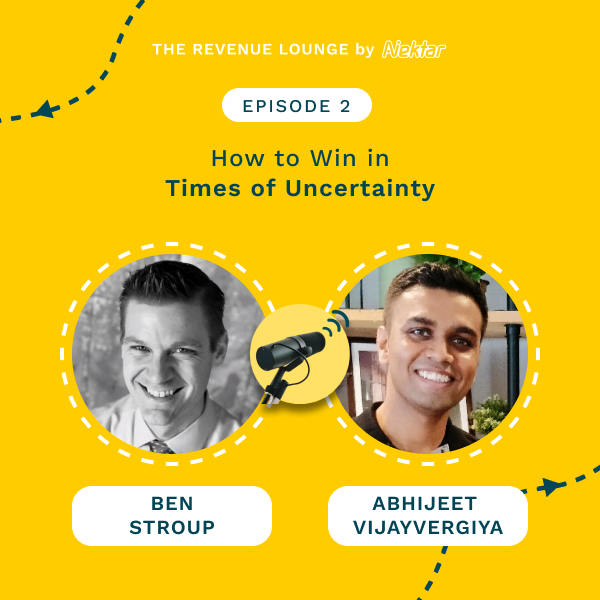
Ep #2: How to Win in Times of Uncertainty
Listen Now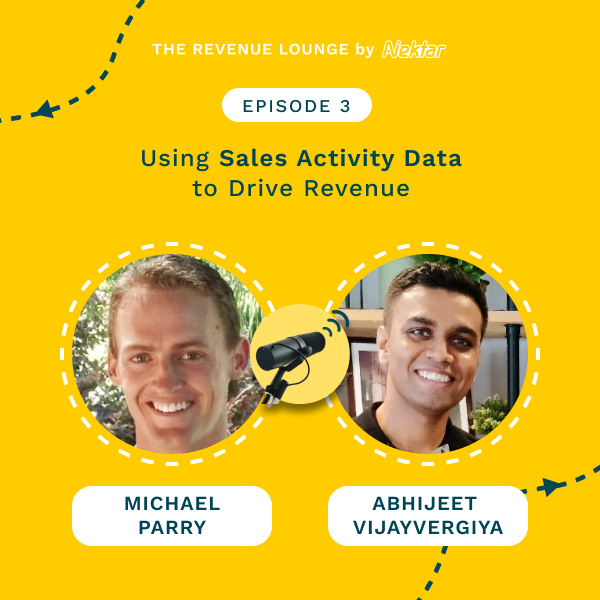
Ep #3: Using Activity Data to Drive Sales Productivity
Listen Now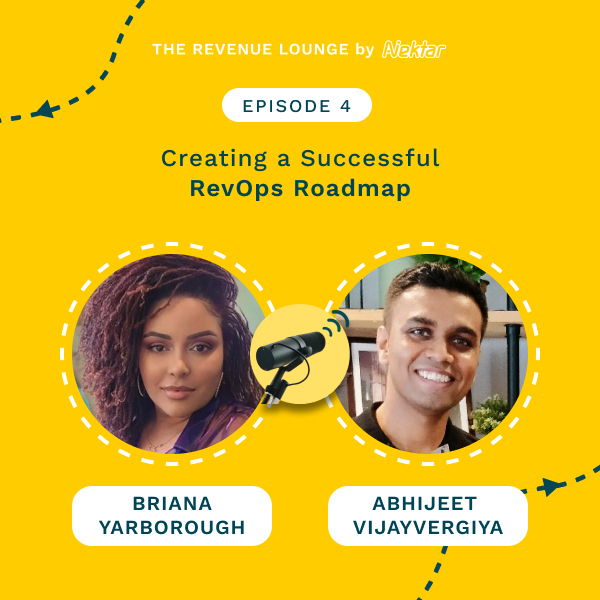
Ep #4: Creating a Successful RevOps Roadmap
Listen Now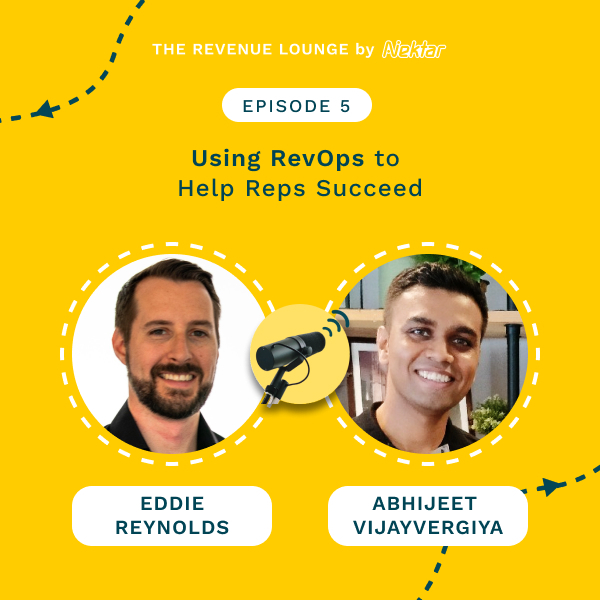
Ep #5: Using RevOps to Help Reps Succeed
Listen Now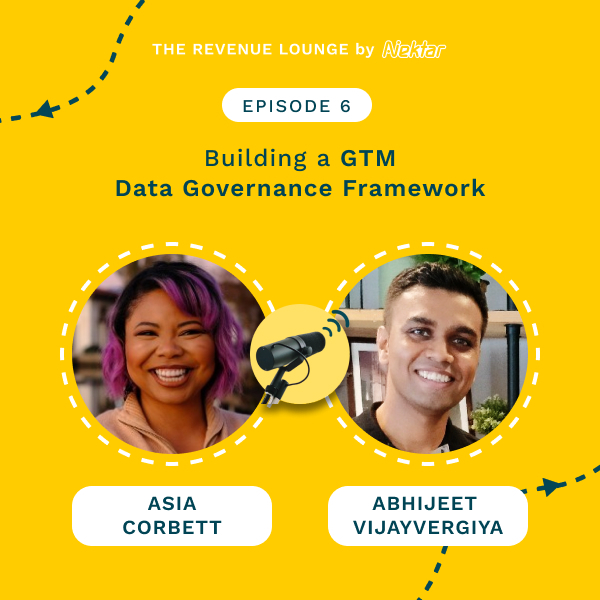
Ep #6: Building a GTM Data Governance Framework
Listen Now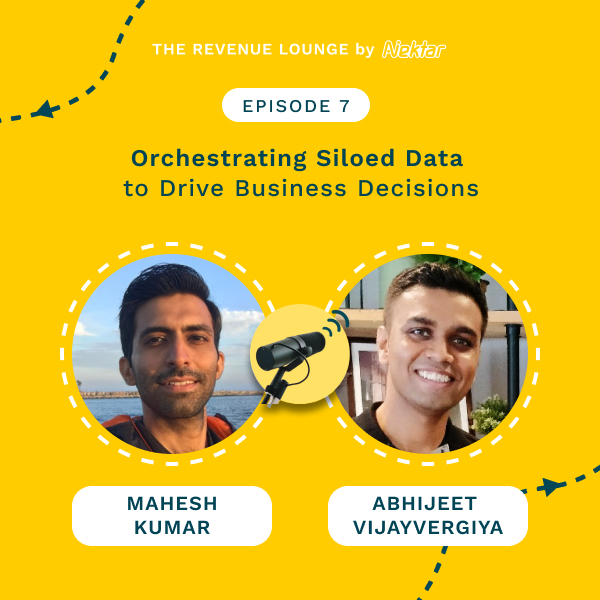
Ep #7: Orchestrating Siloed Data to Drive Business Decisions
Listen Now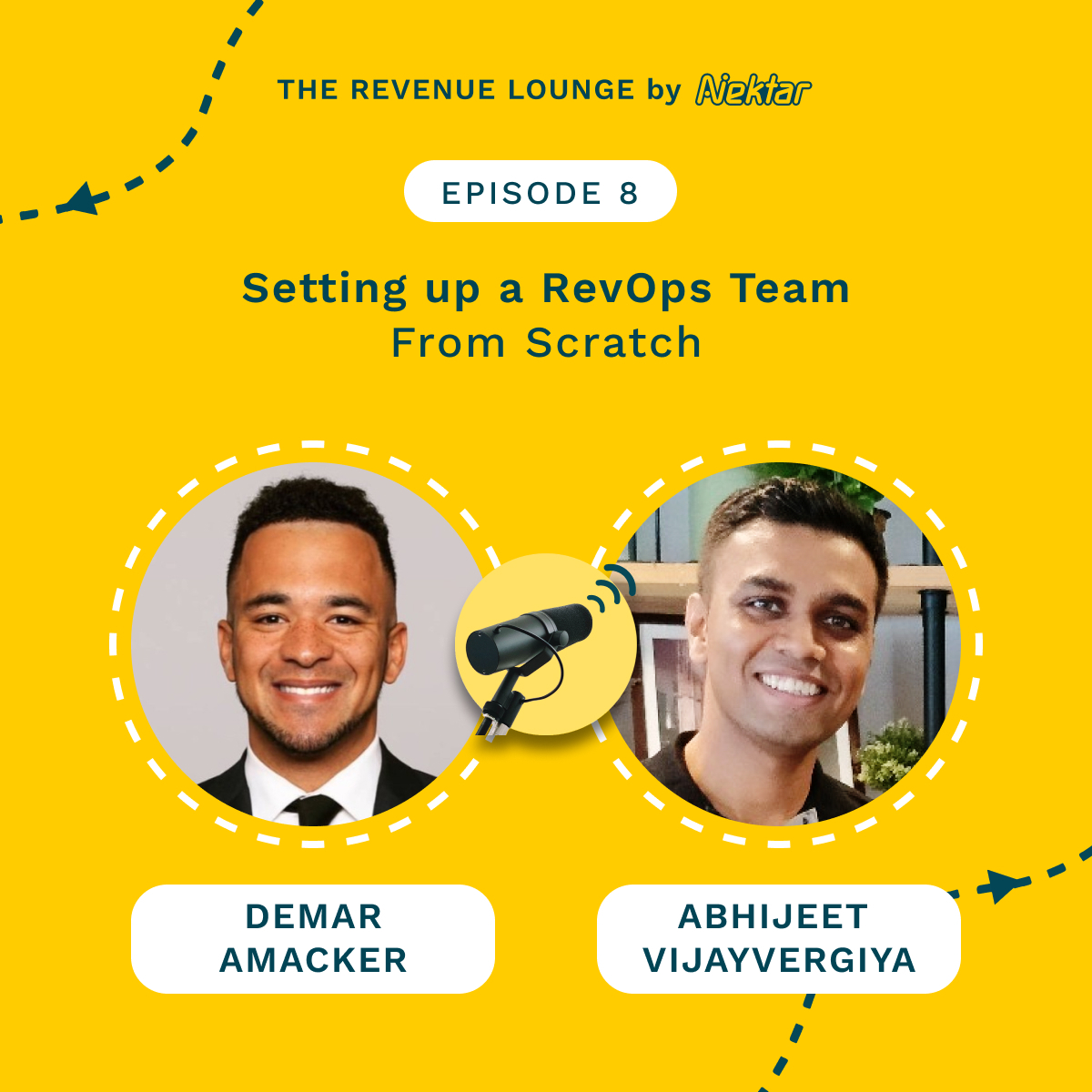
Ep #8: Setting Up a RevOps Team From Scratch
Listen Now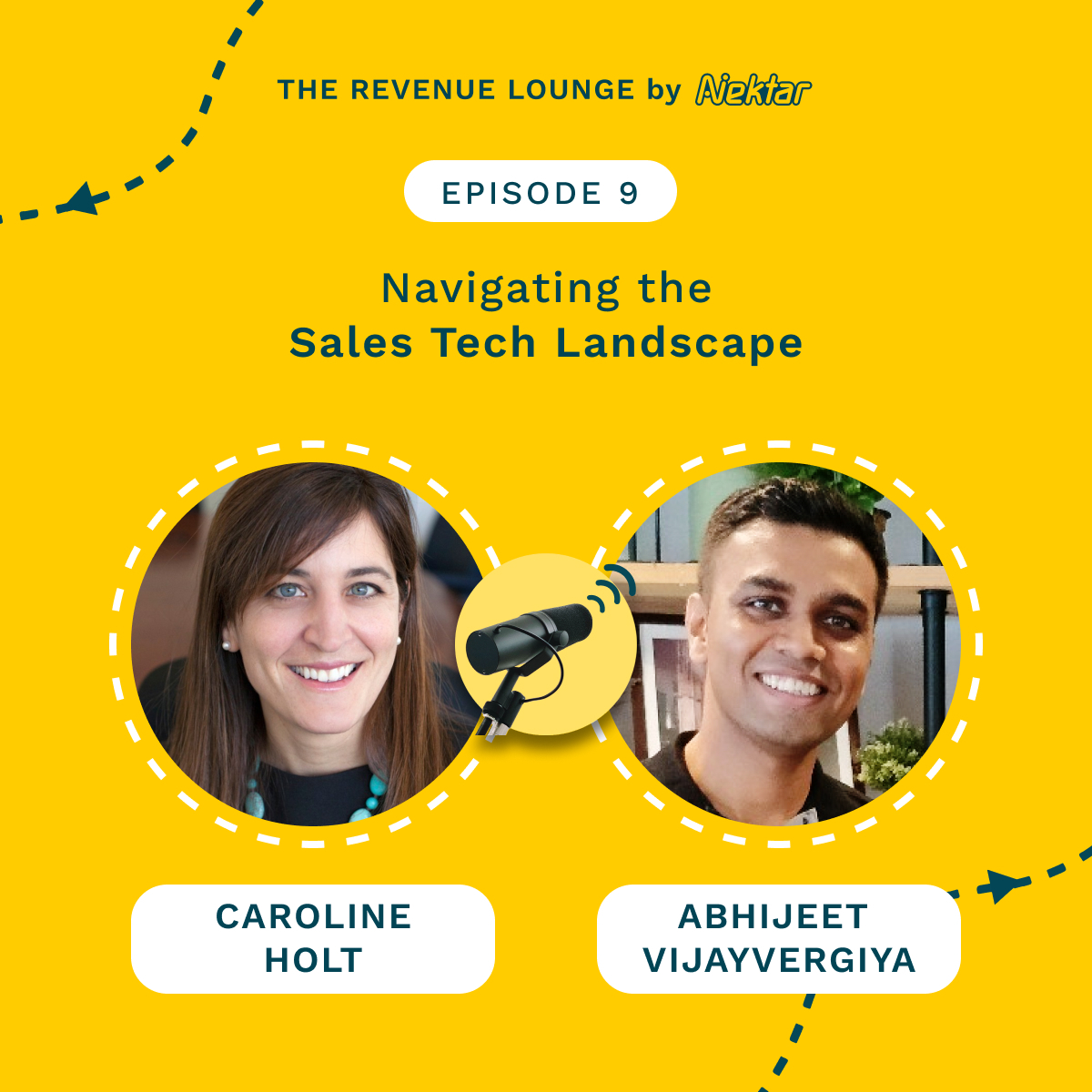
Ep #9: Navigating the Sales Tech Landscape
Listen Now